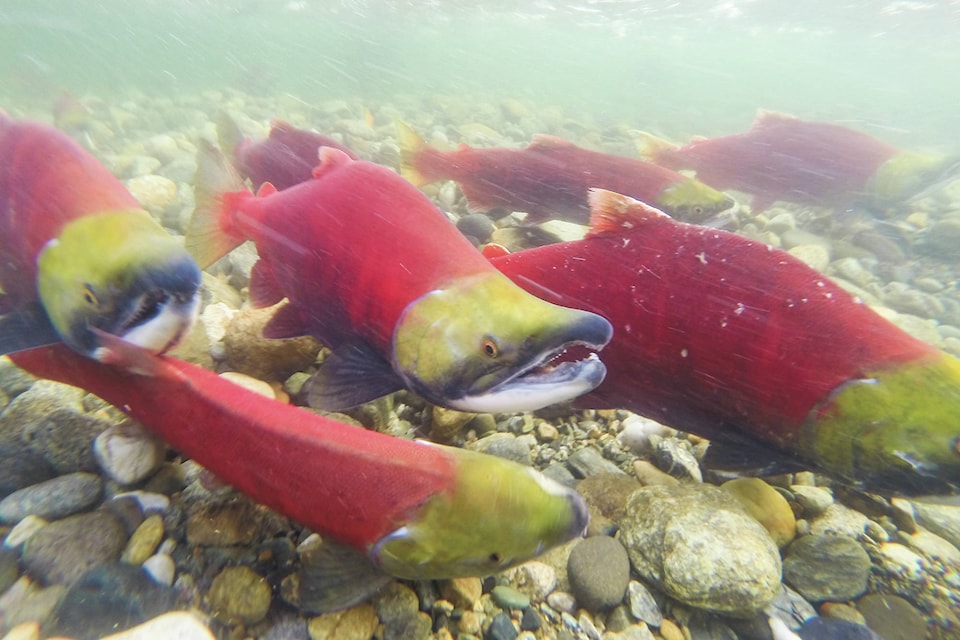Projections for this season’s Fraser River to Shuswap Lake sockeye salmon run are gloomy, although not unexpected during a low point in the four-year salmon cycle.
Every year, several groups of sockeye salmon leave the Pacific Ocean to return to their spawning grounds throughout the province. This is the fourth, and often lowest, return year in the cycle for salmon navigating the Fraser River to Shuswap Lake to spawn in the Adams and Eagle rivers, a run that is beginning now and will peak in October.
But there is a bright spot. A little further east, there is reason to celebrate at Scotch Creek, where another group of sockeye have been arriving to spawn since August.
Aaron Arnouse, Little Shuswap Indian Band fisheries co-ordinator, reported 2,372 salmon had passed through the the fish fence on Scotch Creek as of Aug. 31.
“We had the first two fish on the 18th and then there were three quiet nights, with nine only coming in until the 22nd, then on the 22nd, 28 showed up and then they started coming in steady on the 24th,” he said, noting this is the third, and often lowest return year of a four-year cycle. “Only 980 came through last year and we’re well above that, and this is supposed to be the bad year.”
Arnouse says some fish are continuing to arrive at the fence at night but notes the peak night was Aug. 26 when just under 6oo showed up.
He says those that arrive are heading farther up the creek to spawn this year because of high water that restructured the stream bed during this year’s freshet.
Concerns are rising about the health of the remaining returning salmon returning to Scotch Creek because of water levels and temperatures that ranged from 17 C to 20 C last week.
“The water level is pretty low,” said Arnouse, noting the salmon hide from predators and people “scrambling about” in the mouth of the creek during the day.
He is calling for increased education on the salmon and their needs as they return to spawn and says one of his workers recently got into an argument with a belligerent swimmer.
“Sockeye only have so much energy to spawn; they can’t be spending it ducking and dogging around everything. They’ve travelled over 600 kilometres and they stop eating once they leave the ocean.”
Meanwhile, conditions are still good on the Fraser River. The concern is the number of returning fish.
“Returns right now for all the groups are coming in near the bottom end of the forecast range,” said Dean Allan, acting area chief of resource management for the Fraser and Interior Area of Department of Fisheries and Oceans (DFO).
Members of the Pacific Salmon Commission collect data from test fisheries and meet twice a week with the Fraser River Panel to talk about the latest available information.
“If there’s recommendations on run sizes, the panel will hear recommendations and will either adopt them or not,” says Allan, noting the panel is made up of reps from both Canada and the U.S. “For total late-run returns, the in-season estimate is 247,000 sockeye.”
Allan adds the number of sockeye returning to the Shuswap in this low-run year is forecast to be 58,000.
But, he cautions the salmon are part of an aggregate total that includes the Weaver Run, which includes salmon heading into the Harrison drainage.
“What we’ve seen so far is coming in at the low end of the forecast at the P25 rate, which means there is a 75 per cent chance the escapement will be below forecast and a 25 per cent chance it will be above,” he says. “Migration conditions are pretty good so that’s optimistic for fish getting to the spawning grounds; I don’t know if they’re delaying but obviously it’s a good thing if they do.”
Late-run sockeye usually begin gathering in water off the mouth of the Fraser River, beginning the trip home in early September, peaking in early October.
Allan says water flow in the Fraser is a bit above the long-term minimum discharge (flow) and close to 2015 water levels.
The good news is if the discharge is lower, it’s easier for fish to swim. The not-so-good news is that a combination of low water and high temperatures can make the salmon more susceptible to disease or mortality.
But Allan says conditions are actually pretty good for those fish.
“Overall temperatures didn’t get as warm as were expected; they were starting to climb earlier in August and then dipped a bit in the main stem of the Fraser,” he says. “The Thompson River is about a degree higher than the long-term average, which is not too bad.”
Continuing heat and lack of rain could become a problem, however, he points out the nights are now longer and cooler, which helps.
Next year will be a dominant run, when the offspring of the 1.04 million who embarked on the long journey to the ocean in 2014 will head up the Fraser River to spawn in 2018.
